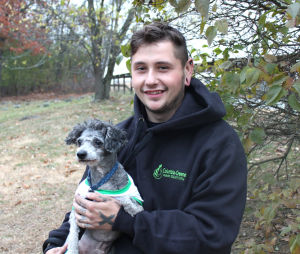After much deliberation, I came up with the following compilation of first-aid supplies that are now de rigueur on our outings. Although the list looks extensive, all of the items can be carried in mid-sized cosmetic case, which tucks into even a small-ish fanny pack.
>> Leash and non-slip collar: Keep this at the ready, not buried at the bottom of pack, in case you need to restrain your dog at a moment’s notice (even if you do normally have dog off-leash).
>> Whistle: to summon help; to let others in your party know where you are if you split up; to call your dog or help him locate you if you should get separated (especially if he is whistle-trained). I like for each person in party to have one for communication.
>> Gauze pads: for wounds
>> Gauze wrap: for wounds
>> Adhesive tape: to secure gauze or bandage
>> Vet wrap or self-stick bandage: for a more secure way of securing larger areas that need protection
>> Scissors: to cut tape, bandages; to cut away dog’s coat if it is long and blocks view of injury
>> Small needle-nosed pliers: to remove porcupine quills; to cut wire if dog gets tangled in it
>> Tweezers: to remove prickers, briars, thistles
>> Panty hose legs: to serve as muzzle; to help restrain dog
>> Antibiotic ointment: for small scrapes and wounds
>> Betadine or antiseptic wash: use as antiseptic wash
>> Small squeeze bottle of water (fresh, clean): to rinse out wound
>> Alcohol wipes: to clean pliers, scissors before using
>> Antiseptic hand cleaner: to clean your hands before working on a wound
>> Latex or rubber gloves: Who knows what icky things your dog might get into!
>> Benedryl: in case of allergic reaction or buffered aspirin: if dog is in pain due to injury. Talk with your vet about dosages and when/how/if to use appropriately.
>> SprayShield: if a threatening animal gets too close to you or your dog
>> Emergency blanket (those small, compact silver ones for keeping in car or for hikers): Not only will this keep your dog warm if it’s a cold day, after the sun goes down, or if he starts to go into shock, but it can also be used by you and another person as a “sling” to transport an injured dog. In extreme cases, the reflective surface could be used as a flash signal to summon help.
>> “Cheater” glasses: If you need glasses to read, you will need them to treat a wound or remove quills, splinters! Don’t be caught with all the proper emergency supplies — and not be able to use them because you can’t see!
>> Dog ID tag: Even though my dog has a microchip, I always keep his physical ID tags on when we are out so that if we get separated and someone picks up my dog, she can call me immediately, without going through the process of having a vet or shelter reading the chip. By using a two-sided tag, I can have my home contact info on one side and common “while visiting phone numbers” on the other. (Tip: forgo putting dog’s name on tag, and use the additional engraving line for a helpful number or address.)
>> Water: Although this isn’t an emergency supply, it is important to remember to provide water for your dog. Unless you are fully confident that there is a ready supply of fresh, clean water on the trail — and that your dog is comfortable drinking from streams or ponds — carry water for him. Bring either a collapsible water dish that will fit in your fanny pack and share your supply with him, or bring a “Gulpee,” a water bottle that has an attached drinking tray for the dog.
If traveling with dog, keep in car:
>> Copy of recent vet records: In case you have to make an emergency visit to a new, out-of-town vet, have list of recent shots, any allergies, and any health issues a vet should be aware of.
>> Copy of microchip info: In case you and your dog get separated, it is good to have this info for quick reference
>> Recent photo of dog: If you get separated, it might come in handy. Photo should be recent and show distinguishing marks/features (no, not a photo of Pooch dressed up as a pumpkin for Halloween!).
>> Seat belt/harness/crate for travelling: that’s probably another story!
I know the current trend in running, hiking and biking is to “Go Lite,” but sometimes it is worth carrying a little extra weight for the safety of our buddies. Carrying supplies shouldn’t be limited to only out-of-the-way or lengthy hikes — even when close to home, it is a good idea to carry a first-aid kit. A mile is an awfully long distance when trying to maneuver a wounded or sick dog to safety.
There are some lessons we don’t want to learn the hard way, and being out in the woods with an injured dog and no way to help him is near the top of that list. Believe me, an extra pound in your pack lightens the burden of responsibility for another creature that sits heavily on your shoulders.”
***
Charlene Marchand is the Chairperson of the Columbia-Greene Humane Society/SPCA Board of Directors. She may be contacted by e-mail at [email protected].

 RSS Feed
RSS Feed